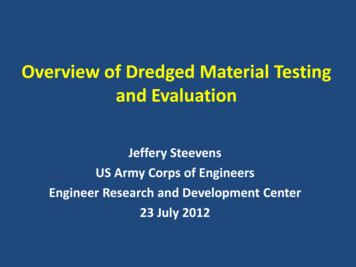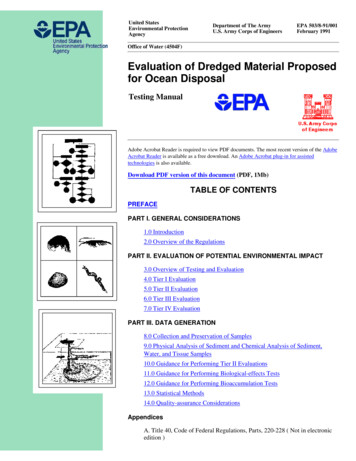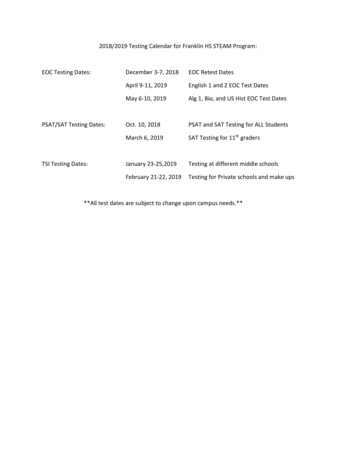
Transcription
Overview of Dredged Material Testingand EvaluationJeffery SteevensUS Army Corps of EngineersEngineer Research and Development Center23 July 2012
Guidance Documents for Management ofDredged MaterialNational Technical Guidance Technical Framework Inland Testing Manual Ocean Testing Manual Upland Testing Manual Ocean Site Designation Manual Site Management & MonitoringFound at:el.erdc.usace.army.mil/dots/guidance.html
Inland Testing Manual Addresses CWA Interim guidance in 1976,updated in 1998 Included:– Effects-based testing– Sequenced TieredDM placement “will notcause “an unacceptableadverse impact”
Ocean Testing Manual Addresses MPRSA Originally developed in1977, updated in 1991 Included:– Effects-based testing– Bioaccumulation– Sequenced TieredDM placement in ocean will not“unreasonably degrade orendanger: human health,welfare, or amenities, marineenvironment, ecological systems,or economic potentialities”
Risk Assessment and ManagementData Acquisition, Verification, and sCharacterizationManagement Process that evaluates the likelihood that adverse effects mayoccur or are occurring as a result of exposure to one or morestressors (USEPA 1997). Risk management is an approach to consider the outcome anduncertainty of an assessment and mitigate risk through a rangeof alternatives.
Conceptual Model:Open Water Placement of DMPathwaysDredged MaterialPlaced in FishDirect dlife
Identify Contaminants of ConcernResponseAt what concentration will an adverse effect will occur?EffectClClClClNo EffectCl01050100Chemical ConcentrationImportant FactorsDichlorobenzeneHalf life 10 daysClClClHexachlorobenzeneHalf life 6 years Chemical properties: mobility, bioavailability, persistence Toxicological significance (Cr6 vs Cr3 ) Potential to bioaccumulate
TIER I Existing DataTIER II Physical/Chem. data Screening Tests Predictive modelsTIER III Toxicity Bioassays Bioaccumulation BioassaysTIER IV Chronic Sublethal Bioassays Steady-State Bioaccumulation Bioassays Risk Assessment
Tier I: Existing Information Examine existing information– Contaminant sources Pathways of contaminant sources Spill information– Physical characteristics of site Bathymetry, currents, deposition, time since lastdredging was required– Prior physical monitoring
Tier I: ExclusionsMPRSA, 40 CFR 227.13 (b)(1) dredged material is composed primarily of sand, gravel, rock,AND is found in areas of high current or wave energy, OR (b)(2) material is for beach nourishment and composedpredominantly of sand, gravel, or shell, with particle sizes compatiblewith the receiving beach, OR (b)(3)(i) material is substantially the same as disposal substrate, AND(ii) sediments are far removed from known historical sources ofpollution
Tier I: ExclusionsCWA, 40 CFR 230.60 230.60 (a) “material not a carrier of contaminants” Composed primarilyof sand, gravel or other naturally occurring inert materials, Generallyfound in areas of high current or wave energy 230.60 (b) “sufficiently far removed . “ If sediments are from depthsdeposited in preindustrial times and not exposed to modern sources ofpollution, mineral deposits are considered contaminant sources 230.60 (c) “adjacent to . “ the discharge and excavation sites areadjacent, concentrations of contaminants are not substantially different,the geochemical environments are similar, then, the bioavailability ofcontaminants at the two sites are likely to be similar. Technologies suchas capping or underwater containment are potentially applicable. 230.60 (d) “if constraints are available ” “if constraints are available toreduce contamination to acceptable levels within the disposal site and toprevent contaminants from being transported beyond the boundaries ofthe disposal site ”
Tier II: Overview Predictive models using physical and chemical data(e.g., chemical analysis of sediments) Approaches– Water column effects? Use sediment and elutriate chemistry to determine compliance withrelevant water quality criteria/standards– Benthic effects? Use sediment chemistry to determine potential for accumulation ofcontaminants in biota
TIER II: Water Column EffectsTwo-Step Process Screening step: chemical analysis data used for conservativeestimate of release to water (assumes 100 % of allcontaminants measured in sediment are released to watercolumn) Chemical analysis step: Use chemicalanalysis of elutriate to estimatereleases to water column Both steps utilize a predictive mixingmodel (STFATE)4 parts water *1 part ddainfo.html
Must meet WQC after4 hours of mixingMust meet WQC at all timesMixing ZoneDMSediment
Tier II: Benthic EffectsThermodynamically Based Bioaccumulation Potential A model-derived estimate of steady-state concentration ofchemicals in an organism Good only for non-polar (hydrophobic) organics– PAHs, PCBs, Dioxins, Chlorinated pesticides Used as a screening tool to determine if bioaccumulation testingis warranted
Tier II: Calculation of TBPCt BSAF xCs%TOCx %LCt Whole-organism concentration; Cs conc. in sediment; %L lipidcontent of organism; %TOC total organic carbon content ofsediment; BSAF biota sediment accumulation html
Tier III: Overview Bioassays– Elutriate toxicity bioassay– Sediment toxicity bioassay– Sediment bioaccumulation bioassay Conduct bioassays if:– Tier I and II evaluation suggests the DM may containcontaminants that might result in adverse effects– No WQS for contaminants of concern– Potential for synergistic interactions between chemicals18
Tier III: Elutriate BioassayDesign At least 3 concentrations control survival 90% 5 replicates/10 organisms 48- to 96-hourdurationMortality4 parts water1 part DM(volume)LC50Americamysis bahiaMenidia beryllina01050Percent Elutriate100
Tier III: Elutriate Bioassay Results2. Model dilution of effluent fromCDF or suspended DM in mixing zone;Compare the modeled concentrationto the LPCMortality1. Determine LC50LC5001050100Percent ElutriateLC50 is 40%Limiting permissible concentration(LPC) is the effect value (or 100%concentration) multiplied by anapplication factor (0.01)For example, LPC 40% x 0.01 0.4%Environment Canada
Tier III: Benthic Toxicity Bioassay Standardized EPA/ASTM protocolsOverlying WaterTest OrganismsSediment Generally 10 day; 28 day chronic testMinimum of 5 replicatesTest validity based on survival in control ( 90% or 80% for amphipods) Compare DM to reference and controlsediments Use two sensitive species representingdifferent life strategies Survival of organisms as toxicologicalendpoint
Tier III: Benthic Toxicity BioassayToxicity Test Evaluation Mortality in dredged material is 10% greater than reference(20% for amphipods), and Statistically different from reference?If No, material is not predicted to be toxicIf Yes, material is predicted to be toxic
Tier III: Benthic Bioaccumulation Bioassay Standardized EPA/ASTM protocolOverlying WaterTest OrganismsSediment 28-day exposureNo feedingMinimum 3 replicates per treatmentCollect and purge organisms at conclusion ofexposure Use 2 different organisms Sediment ingester, tolerant of contaminants,adequate mass, poor metabolizer of chemicals Accumulation of chemicalsof interest in organisms asendpoint Compare DM to reference sediment
Tier III: Benthic BioaccumulationInterpretationConcentration of contaminant in organism exposed to dredgedmaterial greater than reference?If Yes, consider Number of species testedNumber of contaminants referenceMagnitude of bioaccumulationToxicological importanceBiomagnification potentialComparison to backgroundCompare with critical body residues (CBRs)Risk based interpretation using tools such as food web modeling
Upland Testing Manual Addresses evaluation of DM forupland placement Published in 2003 Included:– Tiered approach to assesscontaminant releases– Focused on contaminantpathways and use of a conceptualmodel– Goal is to determine need/extentof contaminant controls
Tier I: Develop Conceptual Model forUpland Placement of Dredged hat arecontaminants ofconcern?FishSeepageAquaticInvertebrates
Tier II: Screening Predict volatile losses (compare to OSHA, Human Health values)Predict plant and animal uptake (compare to reference)Predict effluent, runoff, leachate concentrations (WQC/WQS)Refine Contaminants of Concern FishSeepageAquaticInvertebrates
Tier III: Biological Bioassay Bioaccumulation– Terrestrial Animal Bioaccumulation Bioassay– Plant Bioaccumulation Bioassay Toxicity– Effluent toxicity BioassayEarthworm bioaccumulation bioassayASTM Method E-1676-04Spartina alternifloraSmooth cordgrassCyperus esculentusYellow Nutsedge
Tier III: Physical Testing Effluent and runoff––––Column settling testEffluent elutriate testSimplified laboratory runoff procedure (SLRP)Rainfall Simulator/Lysimeter System (RSLS) Leachate– Sequential Batch Leach Test (SBLT)– Pancake Column Leach Test VolatilizationColumn settling test– Laboratory Volatile Emission Test ProcedureColumn leach testVolatile flux chamberField analysis of volatiles
Tier III: Physical Modeling Mixing (effluent/runoff discharges)–––––Dilution volumeCornell Mixing Zone Expert System (CORMIX)Macintyre Analytical Method for CDF Discharge in Riverine ConditionsFasttabs Modeling System for Evaluation of Hydrodynamic TransportDilution Volume Method for CDF Effluent Discharges Volatile emissions and dispersion (on and off-siteconcentrations)0.1NA (ng/cm2.h)pyrene- experimentalmodel fit - "wet"0.010.0010100200Time, hours300400
Regional Implementation Agreement Completed in 2003 Region specific guidance–––––ProcessReference locationsAcceptable bioassaysContaminants of concernTarget detection cean/odmd sites.html
TerminologyEffects based approachUse organism to indicate the bioavailability and effects ofcontaminants; contaminant effects are used to make a determinationReference SedimentA sediment which reflects disposal site conditions except previousdredged material disposal. It is the point of comparison forinterpreting test/bioassay results.Control Sediment/WaterA sediment from the area where the organisms were collected orcultured. For water-column bioassays, water in which the organismswere held or cultured is used. The control serves as a check on thehealth of the organism and validates the bioassay results.
US Army Corps of Engineers . Engineer Research and Development Center . . National Technical Guidance Technical Framework Inland Testing Manual Ocean Testing Manual Upland Testing Manual Ocean Site Designation Manual Site Management & Monitoring . control survival










